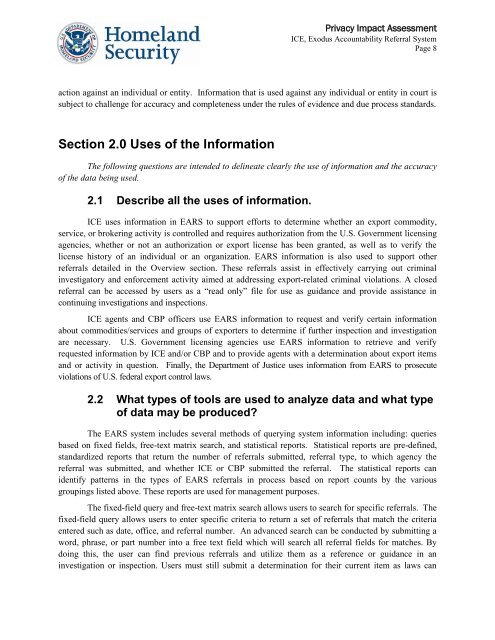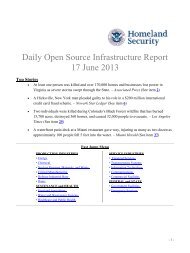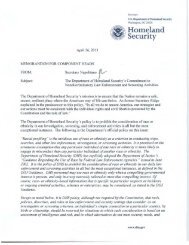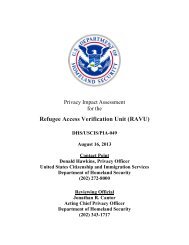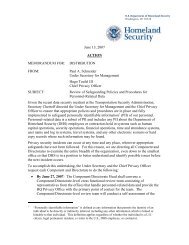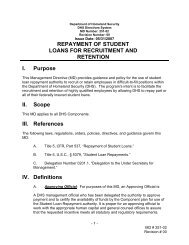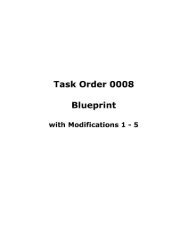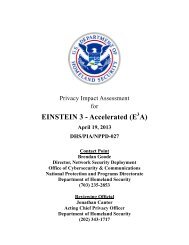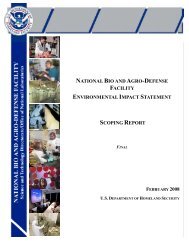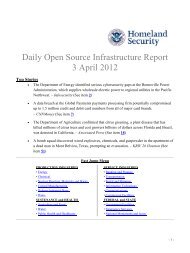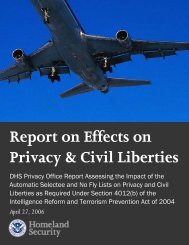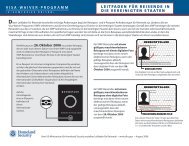Exodus Accountability Referral System (EARS) - Homeland Security
Exodus Accountability Referral System (EARS) - Homeland Security
Exodus Accountability Referral System (EARS) - Homeland Security
Create successful ePaper yourself
Turn your PDF publications into a flip-book with our unique Google optimized e-Paper software.
Privacy Impact Assessment<br />
ICE, <strong>Exodus</strong> <strong>Accountability</strong> <strong>Referral</strong> <strong>System</strong><br />
Page 8<br />
action against an individual or entity. Information that is used against any individual or entity in court is<br />
subject to challenge for accuracy and completeness under the rules of evidence and due process standards.<br />
Section 2.0 Uses of the Information<br />
The following questions are intended to delineate clearly the use of information and the accuracy<br />
of the data being used.<br />
2.1 Describe all the uses of information.<br />
ICE uses information in <strong>EARS</strong> to support efforts to determine whether an export commodity,<br />
service, or brokering activity is controlled and requires authorization from the U.S. Government licensing<br />
agencies, whether or not an authorization or export license has been granted, as well as to verify the<br />
license history of an individual or an organization. <strong>EARS</strong> information is also used to support other<br />
referrals detailed in the Overview section. These referrals assist in effectively carrying out criminal<br />
investigatory and enforcement activity aimed at addressing export-related criminal violations. A closed<br />
referral can be accessed by users as a “read only” file for use as guidance and provide assistance in<br />
continuing investigations and inspections.<br />
ICE agents and CBP officers use <strong>EARS</strong> information to request and verify certain information<br />
about commodities/services and groups of exporters to determine if further inspection and investigation<br />
are necessary. U.S. Government licensing agencies use <strong>EARS</strong> information to retrieve and verify<br />
requested information by ICE and/or CBP and to provide agents with a determination about export items<br />
and or activity in question. Finally, the Department of Justice uses information from <strong>EARS</strong> to prosecute<br />
violations of U.S. federal export control laws.<br />
2.2 What types of tools are used to analyze data and what type<br />
of data may be produced?<br />
The <strong>EARS</strong> system includes several methods of querying system information including: queries<br />
based on fixed fields, free-text matrix search, and statistical reports. Statistical reports are pre-defined,<br />
standardized reports that return the number of referrals submitted, referral type, to which agency the<br />
referral was submitted, and whether ICE or CBP submitted the referral. The statistical reports can<br />
identify patterns in the types of <strong>EARS</strong> referrals in process based on report counts by the various<br />
groupings listed above. These reports are used for management purposes.<br />
The fixed-field query and free-text matrix search allows users to search for specific referrals. The<br />
fixed-field query allows users to enter specific criteria to return a set of referrals that match the criteria<br />
entered such as date, office, and referral number. An advanced search can be conducted by submitting a<br />
word, phrase, or part number into a free text field which will search all referral fields for matches. By<br />
doing this, the user can find previous referrals and utilize them as a reference or guidance in an<br />
investigation or inspection. Users must still submit a determination for their current item as laws can


